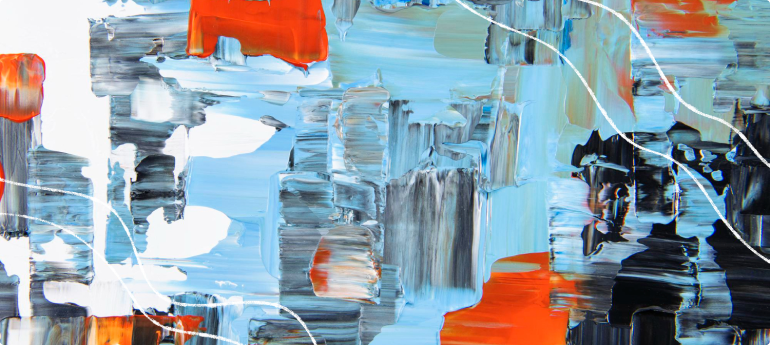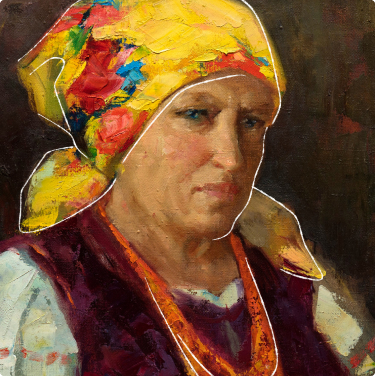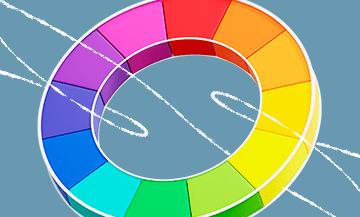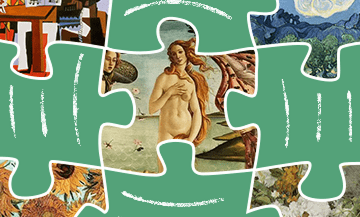Ernst Gombrich
In our world, technology rapidly changes, and the flow of information continually increases, making the question of the meaning of art particularly pressing.
Why do we need colors, sounds, movements, and forms when we have an endless ocean of digital impressions at our disposal?
This article invites us to reflect on how art intertwines with our lives, reveals the depths of human existence, and becomes the key to understanding ourselves and the world around us.
Let us dive into the world of creativity and unravel the mystery of why art remains an integral part of our existence.
Art: what is it?
First of all, it is necessary to define what we mean by the concept of “art.” So, art is the reflection of the surrounding reality and the inner state of a person in artistic images.
These images can manifest in dynamic forms (film, dance) or remain static (painting, sculpture). They can be auditory (song), visual (painting), or combine both auditory and visual components (film, music video).
Art is the language through which artists, musicians, writers, and dancers communicate with the world, with themselves, and of course, with us.
Art defies rigid definitions; it is free and elusive, like the wind carrying the scents of different eras and cultures. It can make us smile, cry, reflect, or even change our perspective on the world.
So, what is art? It is the mysterious force that makes our lives rich and astonishing, like magic that manifests in every tiny detail of our existence.


Historical excursion: the origin and development of art

Primitive Experiments
Art emerged when primitive people realized the power of their imagination and sought to capture their world. The first manifestations of art are found in ancient times: cave paintings, decorations on bones and stones symbolizing life and hunting. These arts not only served as a means of communication but also testified to the richness of human imagination.

Art of the Ancient World
With the advent of civilizations and the development of cultural exchanges, art became more complex and symbolic. The ancient Greeks and Romans built temples, created sculptures, and immortalized their history on vases.
Thanks to Eastern civilizations (Chinese and Indian), unique techniques of painting and sculpture emerged.

Medieval Period: Sacred Art
The Middle Ages brought with it an era of sacred art. Churches were filled with stained glass windows and frescoes depicting biblical stories. Medieval masters created books of art, luxurious manuscripts adorned with exquisite miniatures.

Renaissance: A Return to Beauty
The Renaissance period in Italy marked a return to ancient ideals. Artists like Leonardo da Vinci, Michelangelo, and Raphael created works that amazed with their beauty and harmony.
It was an epochal moment when humanity turned once again to art as a source of inspiration and elevation.

Art of the Modern Era
With the development of technology and the rise of public consciousness, art underwent radical changes. From Impressionism to Surrealism, artists began experimenting with form, color, and context. Abstract art and Modernism opened new horizons and blurred the boundaries between reality and fantasy.

Contemporary Era: Art in the Age of Technology
And what about now? Contemporary art has become diverse and multifaceted, including video art, digital installations, and conceptual works. Artists now address social, political, and environmental themes, embodying their boldest ideas in their work.
Thus, art, which began with simple drawings on cave walls, has transformed into an astonishing variety of forms and expressions. It is a mirror of our history, culture, and spirituality. And while art may change its forms, its essence remains unchanged — the embodiment of human imagination and the quest for beauty.
Goals and objectives of art
The answer to such a question can be classified as philosophical. The goals and objectives of art are vast, reflecting the complex mosaic of human existence:
- Expression of Emotions and Thoughts: Art is a unique channel for expressing complex emotions that are sometimes hard to convey in words. Artists, musicians, writers, and other creators use their works to communicate feelings, ideas, and impressions.
- Reflection of Society: Art also serves as a mirror of society with its values, problems, changes, and transformations. Artists often showcase their vision of the world through their creations, either warning or inspiring people.
- Creation and Innovation: Through art, individuals demonstrate their creative essence and invent something new for the world. Artists frequently discover new forms and techniques, which in turn influence various areas of human activity.
- Education and Cultivation: Art contributes to education and cultural development. It is an effective means of transmitting knowledge, history, and values from one generation to the next.
- Therapeutic Impact: Art can even act as a healer. Many people find comfort and healing in creativity, whether it is painting, music, dance, or other forms.
Thus, art is not only beautiful but also a powerful tool that shapes and enriches our lives.


Kinds of art
The diversity of art forms is truly awe-inspiring. Let’s explore them in more detail:

Painting: In this magic of colors and shapes, artists create amazing works on canvases. From realism to abstraction, each brushstroke is like a magic wand, transforming a white canvas into a world of fantasy.

Sculpture: Stone, metal, and wood come to life under the hands of sculptors. Sculpture allows matter to transform into grace and elegance.

Literature: In the world of words, letters, and ideas, great works are born. Novels, poems, essays — each literary genre is a guide to a world of imagination and thoughts.

Music: Notes, melodies, rhythms — music is a universal language that can touch the deepest strings of the soul. From classical symphonies to contemporary genres, music unites us in a common rhythm.

Theatre: In the theatre, visual and verbal arts come together. Actors, costumes, and sets create realistic worlds in which we laugh or cry — experiencing almost real life.

Film: This is the art of moving pictures, where script, acting, editing, and sound merge into a cohesive whole. Film deeply immerses the viewer and evokes a wide range of emotions.

Photography: In a single frame, photographers capture a moment and preserve it for ages. From portraits to landscapes, photography is the art of reproducing the world in a unique light.

Graphic Art: Comics, illustrations, posters — graphic art visualizes ideas and tells captivating stories through drawing and color.

Contemporary Art: From abstraction to conceptualism, contemporary art emphasizes experimentation and innovation, sometimes sparking heated discussions but always provoking thought.
Each of these art forms is like a window into the boundless world of the human soul, where beauty faces the challenges of time and eternally captivates curious minds.
Mechanisms of the influence of art on the human psyche
Art is undoubtedly one of the most powerful and remarkable expressions of human creativity. It is not only beautiful but also possesses a unique ability to profoundly impact the human psyche.
Art is a language that communicates not only with the mind but also with the deepest corners of our soul. Artists, wordsmiths, and musicians skillfully use colors, shapes, words, and sounds to evoke a whole range of emotions in us. From delight to sadness, from tranquility to intense excitement — a whole world of feelings.
Works of art can be a mirror of our own reality. They reflect our hidden fears, hopes, joys, and sorrows. Communication through art is a therapeutic experience that helps us better understand ourselves and the world around us.
And, finally, art has the power to change our consciousness. Surreal paintings, abstract compositions, and fantastic worlds easily merge into our minds, transporting us to dimensions where reality coexists with fantasy. We expand our thinking and stimulate our creative potential, which exists in every person.

Dopamine plays a key role in the sensation of pleasure and reward, and its levels can rise through interaction with art.
This often occurs when viewing beautiful paintings, listening to music, participating in creative processes, or even simply observing certain aesthetics.
8 reasons why studying art is important and necessary
- Discover the world and yourself
A creative work is the product of an artist’s exploration of the surrounding world. Through the efforts of artists, poets, musicians, and sculptors, we gain the opportunity to view reality through their perspective — through the eyes of the creator.
Moreover, it provides us with a chance to compare this world with our own, which leads to a deeper understanding of ourselves.
- Understand the spirit of the era
Studying art is particularly important because it always reflects the spirit of its time. By analyzing art, we can gain deeper insights into human history and specific historical periods. An artist can convey the mood of an era so accurately that it feels as though the viewer is transported to the past.
- Visit museums
Famous artists’ names cease to be just a string of letters: interesting facts come to life in your mind, turning into a captivating narrative that surpasses the standard tours of average guides.The year of a painting’s creation is no longer just a number, but a key to understanding the context and atmosphere in which it was born. Now you have the opportunity to recreate the surroundings and circumstances that inspired the artist. And, of course, you can share your knowledge with friends and family.
- See the ways art interacts
Artworks always find common ground, exchanging constant allusions. If you want to notice these connections and grasp their deeper meaning, it is important to immerse yourself in the history of art.Understanding the main themes will make it easier to analyze painting, watch films, appreciate music, and read books, as the symbols in them will finally start speaking to you.


- Discover the new in the familiar
By focusing on a particular subject, we begin to notice details that previously eluded our attention. Immersing yourself in the study of art history, you can view even the buildings you pass by daily in a new light.Vincent van Gogh’s famous painting “Starry Night” will cease to be just a cover for a passport; it will transform into a post-impressionist masterpiece created by a master in a psychiatric hospital, who had so many secrets…
- Enhance your perception and find inspiration
In certain professions, a constant visual component is essential. This is especially important for photographers, makeup artists, and stylists. Art can become a source of development and inspiration.Works by artists, filled with amazing color harmonies and unusual compositional solutions, inspire even those who are not involved in visual creativity. Even if your work is far from visual arts, it’s always beneficial to draw some inspiration for successfully tackling everyday tasks.
- Reduce stress
Creativity not only calms but also heals. Scientific research indicates that viewing landscapes contributes to faster recovery after surgical interventions.It can be said that art possesses a unique power to rid us of anxious thoughts that slow down our daily rhythm. It also provides us with a sense of tranquility.
- Contemplate a little
Why does the Mona Lisa smile so mysteriously? What caused the sadness in Frida Kahlo’s painting heroine? What message did Bosch want to convey with his creations?Art encourages us to think, expands the boundaries of our perception, allows us to see more, and motivates us to understand and deeply explore many things, adding greater meaning to our lives.

7 reasons why art makes us happier
Искусство — уникальное явление, пробуждающее в нас эмоции, вдохновение и глубокие размышления. Однако его воздействие на наше благополучие заходит далеко за пределы простого восхищения. Вы знали, что можете стать немного счастливее прямо сейчас? Искусство:
- Develops aesthetic perception
Art teaches us to see beauty in diverse forms and colors. By developing our aesthetic perception, we begin to notice and appreciate the subtle details around us. - Teaches empathy
Empathy is a valuable gift that fosters understanding of others’ emotions. Jean Piaget claimed that maturity comes when we learn to see the world through the eyes of others. This skill is not innate but requires effort and practice throughout life. Art greatly supports the development of empathy. When we view a piece by an artist or writer, we become involved in that person’s reality, connecting with their sense of the world. - Brings joy to everyday life
Regardless of the form, art adds vibrant colors to our routine. The joy from looking at paintings or hearing music leaves a lasting mark on our soul, making us more open to joyful moments. - Reduces stress and anxiety
Art has been proven to have a calming effect on our bodies. Paintings, music, and even dance can lower stress and anxiety levels and restore emotional balance. - Opens your eyes
Let’s agree: in some cases, art is not always comforting. A story might sadden, a painting may cause anxiety, and music might evoke sadness. Nevertheless, art awakens emotions, intensifies them, and helps us discover things we had previously overlooked. - Creates meaning and connection
Art helps us understand and expand our world. Exhibitions, theatrical performances, and concerts are great opportunities for social interaction and sharing impressions. This social connection and community enhance our sense of belonging and improve overall well-being. - Provides pleasure
Many works of art evoke strong emotions. They can shock, confuse, or disappoint, yet each of these emotions, whether fear, disgust, or sadness, does not exclude a sense of pleasure and enjoyment. This is a peculiar aspect of our human nature — hence the love for thrill rides and gripping movies. The Greeks long recognized this pattern, proposing the idea of catharsis: in some cases, negative emotions can awaken positive feelings.
Start your journey into art. Buy a ticket to a museum, dive into the pages of an intriguing book, or immerse yourself in the atmosphere of a theatrical performance — it’s never too late to embrace a creative mood and happiness.


Art and longevity: why go to museums
In a world filled with everyday worries and rapid changes, visiting museums is not just an act of cultural enrichment but a true healing journey. When we immerse ourselves in great works of art, we are transported to eras and cultures where time flows more slowly and the human spirit overcomes all difficulties.
Museums are both repositories of the past and bastions of creativity and inspiration. They offer the chance to see the world through the eyes of great artists, to feel their emotions, and to view our own lives from a new perspective.
Museums, along with reading and live concerts, according to research, have a significant impact on all aspects of our well-being, whereas television programs cannot boast such results.
So, if you want to truly experience the great power of art, it is worth going to a museum rather than hiding in the virtual space of TV or the internet. Only in a museum can you truly feel the ‘aura’ of a work of art, not just its electronic reflections.
Furthermore, visiting museums fosters creativity and imagination. It is a place where ideas are born, and talents find inspiration. In museums, you can finally see how diverse expressions of human genius can be.
Enjoy your time and have a pleasant experience with great art!
Question-answer
Art provides unique opportunities for expressing feelings and thoughts. It is a medium through which people can convey their ideas, emotions, and viewpoints, and also find satisfaction and meaning in it.
Works of art serve as a means for self-expression and reflection, which contributes to emotional impact and therapy.
Art also encourages contemplation, analysis, and critical thinking. Viewing and interpreting artistic works requires the ability to see different perspectives, which enhances intellect.
And finally, art teaches us to appreciate beauty. We become more aware and sensitive to the world around us — a significant advantage for all creative individuals.
Art helps develop emotional intelligence, understand and interpret emotions. Paintings, music, and dance convey complex emotional states and evoke emotional responses.
We learn to see problems from different perspectives and find unconventional solutions. Group projects, such as theatrical productions or exhibitions, foster skills in collaboration and communication.
Analyzing and perceiving art requires the development of critical thinking. People learn to analyze and evaluate works of art, formulate their views, and argue them.
Art encourages the development of imagination, which is also a source of innovative ideas and concepts in other areas of life.
Many forms of art are used as therapy, such as art therapy, music therapy, or dance therapy. These methods help people cope with anxiety, depression, and stress. The creative process stimulates the production of endorphins, which contributes to improved mood and overall well-being.
Art often serves as a bridge between different cultures and worldviews. Exhibitions, literary works, and music broaden perspectives, fostering understanding and empathy. This ability of art to create connections between people can strengthen social bonds and encourage the creation of a more tolerant society.
And, of course, art plays a key role in shaping identity. Through the creative process, individuals develop their unique style and express their distinctive traits. People begin to better understand themselves, their values, and their place in the world.
Art often serves as a voice speaking up for those who are unable or unwilling to express themselves. Artists and creators use their works to raise issues of social injustice, political change, and human rights.Artworks awaken our emotions and imagination, creating a bridge between different layers of society. Musical compositions, films, and literary works unite people from diverse backgrounds, evoking similar feelings and emotions.
The diversity of art invites cultural understanding and tolerance. Exhibitions and events dedicated to various cultures broaden horizons and help overcome stereotypes.
Art also plays a crucial role in economic development, stimulating tourism, the cultural industry, and the creative economy. Cities enriched with art and culture become attractive to investors and entrepreneurs.




